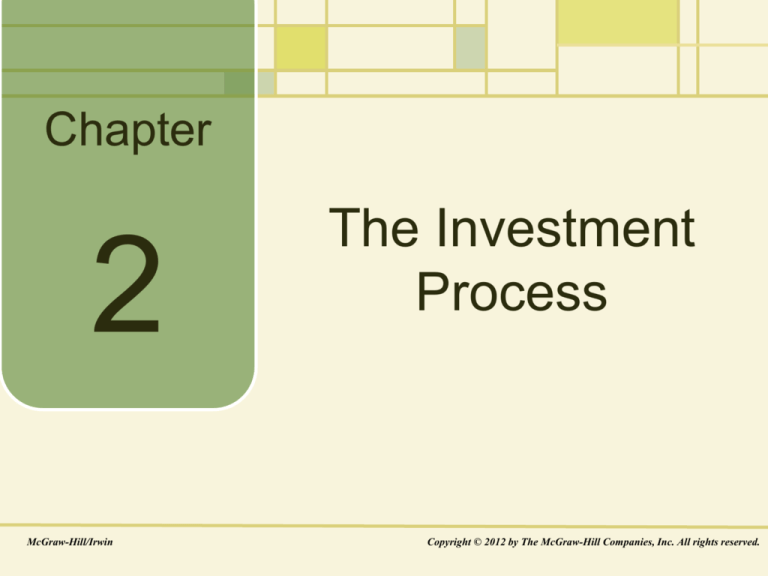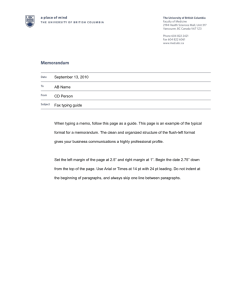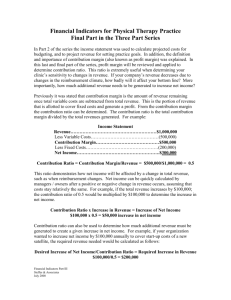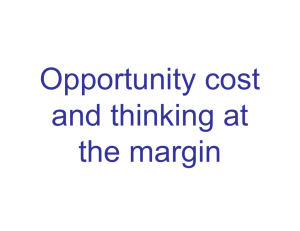
Chapter
2
McGraw-Hill/Irwin
The Investment
Process
Copyright © 2012 by The McGraw-Hill Companies, Inc. All rights reserved.
Investing Overview
• Fundamental Question: Why invest at all?
– We invest today to have more tomorrow.
– Investment is simply deferred consumption.
– We choose to wait because we want more to
spend later.
• Investors have their own investment objectives and strategies
• The Investment Policy Statement (IPS)
– Designed to reflect your objectives and strategies
– Two parts
• Objectives
• Constraints
2-2
Objectives: Risk and Return
• In formulating investment objectives, the individual must
balance return objectives with risk tolerance.
– Investors must think about risk and return.
– Investors must think about how much risk they can
handle.
• Your risk tolerance is affected by
– Your ability to take risk
– Your willingness to take risk
2-3
Investor Constraints
• Resources. What is the minimum sum needed? What are the
associated costs?
• Horizon. When do you need the money?
• Liquidity. How high is the possibility that you need to sell the asset
quickly?
• Taxes. Which tax bracket are you in?
• Special circumstances. Does your company provide any incentive?
What are your regulatory and legal restrictions?
2-4
Investment Strategies and Policies
• Investment management. Should you manage your investments
yourself?
• Market timing. Should you try to buy and sell in anticipation of the
future direction of the market?
• Asset allocation. How should you distribute your investment funds
across the different classes of assets?
• Security selection. Within each class, which specific securities
should you buy?
2-5
Asset Allocation or Security Selection?
•
Is asset allocation or security selection more important to the success of
a portfolio?
•
Most people are inclined to think security selection is the more important
element for successful investing.
•
Research shows, however, that asset allocation is the more important
determinant of portfolio returns. Many experts suggest:
– About 90 percent of portfolio performance stems from asset allocation.
– So, 10 percent of portfolio performance comes from security selection.
•
How is this result possible? Well, consider the Crash of 2008.
– Bonds outperformed stocks in 2008
– Even those elusive “skilled stock pickers” might underperform bonds
•
•
Stocks tend to move together
Even a “skilled stock picker” would have trouble beating bonds if most stock prices are performing
poorly relative to bond prices
2-6
Two Types of Brokerage Accounts
• A Cash account is a brokerage account in which securities are paid
for in full.
• A Margin account is a brokerage account in which, subject to limits,
securities can be bought and sold short on credit.
(more on selling short later)
2-7
Margin Accounts
• In a margin purchase, the portion of the value of an
investment that is not borrowed is called the margin.
• Of course, the portion that is borrowed incurs an interest
charge.
– This interest is based on the broker’s call
money rate.
– The call money rate is the rate brokers pay to
borrow money to lend to customers in their
margin accounts.
2-8
Example: Margin Accounts,
The Balance Sheet
• You buy 1,000 Pfizer (PFE) shares at $24 per share.
• You put up $18,000 and borrow the rest.
• Amount borrowed = $24,000 – $18,000 = $6,000
• Margin = $18,000 / $24,000 = 75%
Liabilities and
Account Equity
Assets
1,000 Shares, PFE
Total
$ 24,000
$ 24,000
Margin Loan
$ 6,000
Account Equity
$ 18,000
Total
$ 24,000
2-9
Margin Accounts
• In a margin purchase, the minimum margin that must be supplied is
called the initial margin.
• The maintenance margin is the margin amount that must be
present at all times in a margin account.
• When the margin drops below the maintenance margin, the
broker can demand more funds. This is known as a margin call.
2-10
Example: The Workings of
a Margin Account, I.
• Your margin account requires:
• an initial margin of 50%, and
• a maintenance margin of 30%
• A Share in Miller Moore Equine Enterprises (WHOA) is selling for $50.
• You have $20,000, and you want to buy as much WHOA as you can.
• You may buy up to $20,000 / 0.5 = $40,000 worth of WHOA.
Liabilities and
Account Equity
Assets
800 Shares of WHOA
@ $50/share
Total
$ 40,000
$ 40,000
Margin Loan
$ 20,000
Account Equity
$ 20,000
Total
$ 40,000
2-11
Example: The Workings of
a Margin Account, II.
•
After your purchase, shares of WHOA fall to $35. (Woe!)
•
New margin = $8,000 / $28,000 = 28.6% < 30%
•
Therefore, you are subject to a margin call.
Liabilities and
Account Equity
Assets
800 Shares of WHOA
@ $35/share
Total
$ 28,000
$ 28,000
Margin Loan
$ 20,000
Account Equity
$ 8,000
Total
$ 28,000
2-12
Example: The Effects of Margin, I.
•
•
•
•
•
You have $30,000 in a margin account, 60% initial margin required.
You can buy $50,000 of stock with this account (why?).
Your borrowing rate from your broker is 6.00%.
Suppose you buy 1,000 shares of Coca-Cola (KO), for $50/share.
Assume no dividends, and that your borrowing rate is still 6.00%,
what is your return if:
– In one year, KO is selling for $60 per share?
– In one year, KO stock is selling for $60 per share,
but you did not borrow money from your broker?
2-13
Example: The Effects of Margin, II.
• KO is selling for $60 per share.
• Your investment is worth $60,000.
• You owe 6% on the $20,000 you borrowed: $1,200.
• If you pay off the loan with interest, your account balance is:
$60,000 – $21,200 = $38,800.
• You started with $30,000.
• Therefore, your return is $8,800 / $30,000 = 29.33%.
• Suppose Coca-Cola stock was selling for $40 per share instead
of $60 per share? What is your return?
2-14
Example: The Effects of Margin, III.
• Coca-Cola stock is selling for $60 per share, but you did not
borrow from your broker.
• You started with $30,000, which means you were able to buy
$30,000 / $50 = 600 shares.
• Your investment is now worth $36,000.
• Therefore, your return is $6,000 / $30,000 = 20.00%.
• Suppose Coca-Cola is selling for $40 per share instead of $60
per share. What is your return in this case?
2-15
Example: How Low Can it Go?
• Suppose you want to buy 300 shares of Pepsico, Inc.
(PEP) at $55 per share.
– Total cost: $16,500
– You have only $9,900—so you must borrow
$6,600.
• Your initial margin is $9,900/$16,500 = 60%.
• Suppose your maintenance margin is 40%. At what
price will you receive a margin call?
2-16
Example: How Low Can it Go? (Answer)
•
This will happen when the price of Pepsico, Inc. drops to $36.67.
How so? Well,
Number of Shares P Amount Borrowed
Maintenanc e Margin Level
*
Number of Shares P *
Solving for the critical stock price, P * , results in
P
Amount Borrowed
Number of Shares
1 - Maintenanc e Margin Level
*
So here,
$6,600
P*
300 22 $36.67.
1 - 0.40
0.60
2-17
Example: Annualizing Returns
on a Margin Purchase, I.
• You buy 1,000 shares of Costco (COST) at $60 per share.
• Your initial margin is 50%.
• You borrow at the 9 percent call money rate plus 2 percent.
• You sell Costco (COST) 4 months later for $63.
• There were no dividends paid (and suppose the prices above are net
of commissions).
• What is your holding period percentage return and your EAR?
2-18
Annualizing Returns on a Margin
Purchase, II.
Answer: First, you have to repay the 3-month loan, so t = (3/12 = .25)
Amount Repaid = Amount Borrowed × (1 + interest rate per year)t
Amount Repaid = $30,000 × (1 + .11).25
= $30,000 × 1.02643
= $30,792.90
Your Sale Proceeds = Cash from Sale – Amount Repaid
= $63,000 – 30,792.90
= $32,207.10
Your Profit = Your Sale Proceeds – Your Investment
= $32,207.10 - $30,000
= $2,207.10
2-19
Annualizing Returns on a Margin
Purchase, III.
Holding Period Percentage Return
$32,207.10 - $30,000 $2,207.10
0.0736
$30,000
$30,000
1 EAR (1 Holding Period Percentage Return) m
(1 0.0736) 4
1.3285
So your EAR is about 32.85%.
Note that there are 12/3 = 4
three-month holding periods in
a year. Therefore, m = 4.
2-20
Other Account Issues, II.
• To invest in financial securities, you do not need an
account with a broker.
• One alternative is to buy securities directly from the
issuer.
• Another alternative is to invest in mutual funds.
2-21
Short Sales, I.
• Short Sale is a sale in which the seller does not actually
own the security that is sold.
Borrow
shares
from
someone
Sell the
Shares
in the
market
Today
Buy
shares
From the
market
Return
the
shares
In the Future
Note that an investor who buys and owns shares of stock
is said to be “long the stock” or to have a “long position.”
2-22
Short Sales, II.
• An investor with a long position benefits from price increases.
– Easy to understand
– You buy today at $34, and sell later at $57, you
profit!
– Buy low, sell high
• An investor with a short position benefits from price decreases.
– Also easy to understand
– You sell today at $83, and buy later at $27, you
profit.
– Sell high, buy low
2-23
Example: Short Sales, I.
•
You short 100 shares of Verizon Communications (VZ) at $30 per share.
•
Your broker has a 50% initial margin and a 40% maintenance margin on
short sales.
•
The value of stock borrowed that will be sold short is:
$30 × $100 = $3,000
Liabilities and
Account Equity
Assets
Sale Proceeds
$ 3,000
Short Position
$ 3,000
Initial Margin Deposit
$ 1,500
Account Equity
$ 1,500
Total
$ 4,500
Total
$ 4,500
2-24
Example: Short Sales, II.
• Verizon Communications stock price falls to $20 per share.
• Sold at $30, value today is $20, so you are "ahead" by $10 per
share, or $1,000.
• Also, new margin: $2,500 / $2,000 = 125%
Liabilities and
Account Equity
Assets
Sale Proceeds
$ 3,000
Short Position
$ 2,000
Initial Margin Deposit
$ 1,500
Account Equity
$ 2,500
$ 4,500
Total
$ 4,500
Total
2-25
Example: Short Sales, III.
• Verizon Communications stock price rises to $40 per share.
• You sold short at $30, stock price is now $40, you are
"behind" by $10 per share, or $1,000. (“He who sells what
isn’t his’n, must buy it back—or go to prison.”)
• Also: new margin = $500 / $4,000 = 12.5% < 40% Therefore,
you are subject to a margin call.
Assets
Liabilities and
Account Equity
Sale Proceeds
$ 3,000
Short Position
$ 4,000
Initial Margin Deposit
$ 1,500
Account Equity
$
Total
$ 4,500
Total
$ 4,500
500
2-26
More on Short Sales
• Short interest is the amount of common stock held in short
positions.
• In practice, short selling is quite common and a substantial volume of
stock sales are initiated by short sellers.
• Note that with a short position, you may lose more than your total
investment, as there is no theoretical limit to how high the stock price
may rise.
• Short Sellers face Constraints.
– From government intervention (i.e., the SEC)
– Also, there might not be enough shares available to borrow to short sell.
– Constraints reduce liquidity, increase volatility, and lead to inefficient
pricing.
2-27
Finding Actual Short Positions
(from finance.yahoo.com)
2-28
Forming a Real Investment Portfolio, I.
• Take the Risk Tolerance Quiz in the textbook.
• What score did you get?
2-29
Forming a Real Investment Portfolio, II.
• What does your score mean?
2-30










